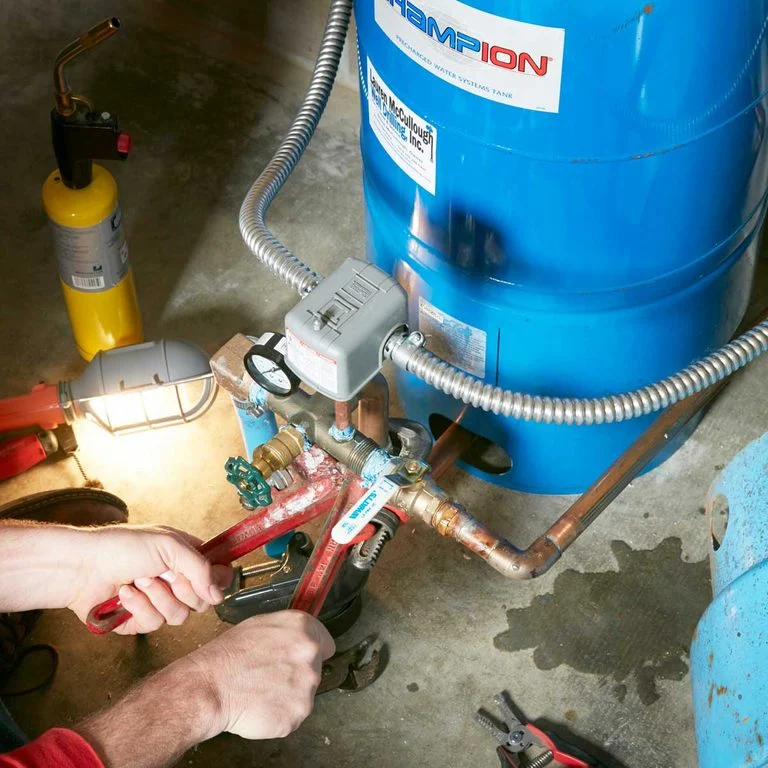Well Pump Troubleshooting and DIY Repair
Introduction
If you own a home with a well, you know that trouble can hit at the worst possible time, and off-hours repairs can cost a small fortune. The most common symptoms of well trouble are no water at all, pulsing water pressure and a well pump that runs constantly. If you experience any of these, there’s a good chance you can solve the problem yourself.
Step 1
Be Sure the Power is On
- Start by checking that the well switch located near your pressure tank hasn’t been switched off.
- Then check the well’s double-pole circuit breaker to see that it hasn’t tripped.
- If it has, reset it.
- A breaker that keeps tripping likely means a problem with the well pump, and you’ll need to call a pro for that.
Step 2
Then Check the Pressure Switch
- You’ll find the pressure switch mounted on a 1/4-in. tube near the pressure tank.
- It’s what senses when water pressure has dropped to the point where the pressure tank requires more water. The switch then powers up the well pump.
- If the switch is bad, it won’t start the well pump and you won’t have water, so testing the switch is your first step.
- Remove the cover and bang a screwdriver handle sharply against the tube below the switch to jar the electrical contacts.
- If you see a spark and the pump starts, the pressure switch is the problem.
Step 3
If the Switch is Bad, Replace It
- If you find the pressure switch is bad, test the pressure tank to make sure it isn’t waterlogged (see Problem: Pulsing Water).
- To replace the switch, start by removing the wires to the old switch and unscrewing the switch.
- Pro tip: Be sure to label the wires!
- Coat the tubing threads with pipe dope or Teflon tape and screw on the new switch so it sits in the same orientation.
- Then reconnect the wires.
- A new switch is about $25. If there’s still no spark, you’ll have to replace the controller.
Step 4
Temporary Quick Fix
If banging on the tube under the pressure switch kicks on the well pump, it means the contact surfaces of the electrical contacts are pitted or burned, causing a poor connection. You can temporarily restore the surfaces to keep it going until you can buy a replacement switch.
- First, turn off the power and double-check with a voltage tester.
- Pull the contacts open and file off the burned and pitted areas using an ordinary nail file or emery board.
- Replace the pressure switch as soon as possible because this fix won’t last long.
Replace the Pump Controller
- Remove the screw at the bottom of the pump control cover and lift it off the box to disconnect it.
- Take it to the store and buy an exact replacement.
- Snap the new cover onto the old box (no need to rewire if you buy the same brand).
- Then start the pump.
- The pump controller houses a capacitor to help start the pump. Most pump controls are mounted in the house near the pressure tank, but others are mounted inside the well pump itself and the fix requires a pro. If you don’t have the box shown below, this fix isn’t for you.
- There’s no way to test the controller, so you either have to risk blowing $75 by replacing a good one, or throw in the towel and call a pro. Replacing the pump controller as shown here is easy, and it’s your last, best shot at avoiding a service call. If you’ve replaced the pressure switch and the pump still won’t start, we think it’s worth the risk to replace the well pump controller.
- The pump controller houses a capacitor to help start the pump. Most pump controls are mounted in the house near the pressure tank, but others are mounted inside the well pump itself and the fix requires a pro. If you don’t have the box shown below, this fix isn’t for you.

Step 6
Check the Pressure Tank’s Air Valve
- Unscrew the plastic cover from the air valve on the top of the tank.
- Use a small screwdriver to depress the air valve to see if water comes out.
- When water “pulses” at the spigot, it usually means you have a waterlogged tank. Replacement is your only option. A new tank costs about $200 and up.
- Two methods for diagnosing a bad tank include checking for water at the air valve and shaking the tank.
- When water “pulses” at the spigot, it usually means you have a waterlogged tank. Replacement is your only option. A new tank costs about $200 and up.

Step 7
Rock the Tank
- Push against the top of the tank to rock it slightly.
- If you can’t rock it or it feels top-heavy, it’s bad.
- Drain it and replace it.

Step 8
Hire a Professional
If your pump runs nonstop, there might not be a DIY solution. When a well pump turns on, you’ll hear the clicking of the pressure switch opening and closing. If you hear frequent clicking when no water is flowing, you have problems outside the house and you’ll need to hire a pro.
It could be a broken water line from the well to the house — usually you’ll have a wet area between the well head and the house — a bad check valve just above the submersible pump at the bottom of the well, a bad connector leaving the well casing or even a broken water line inside the well casing. Each of these problems requires a pro. source





